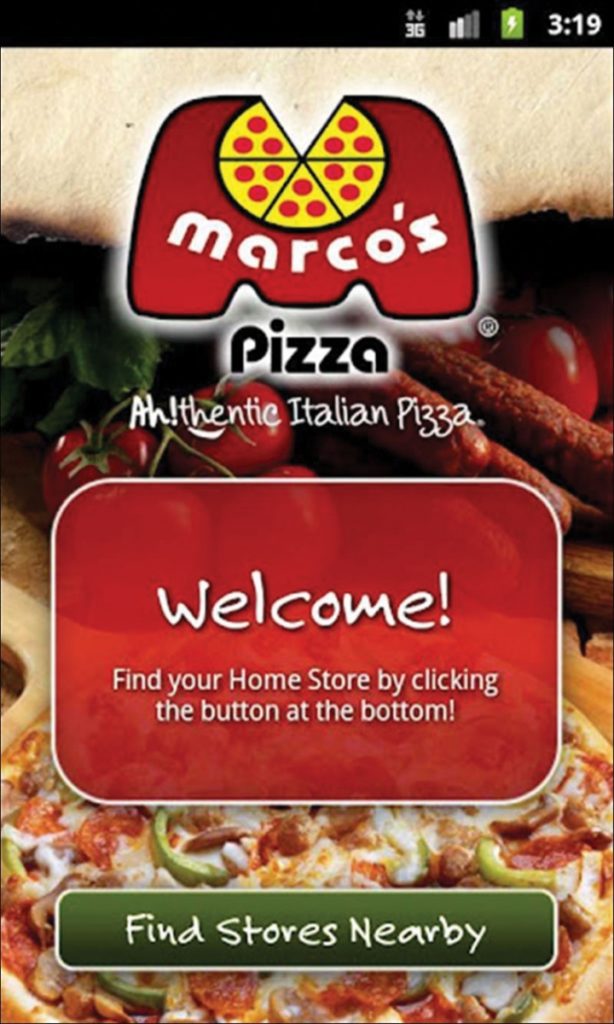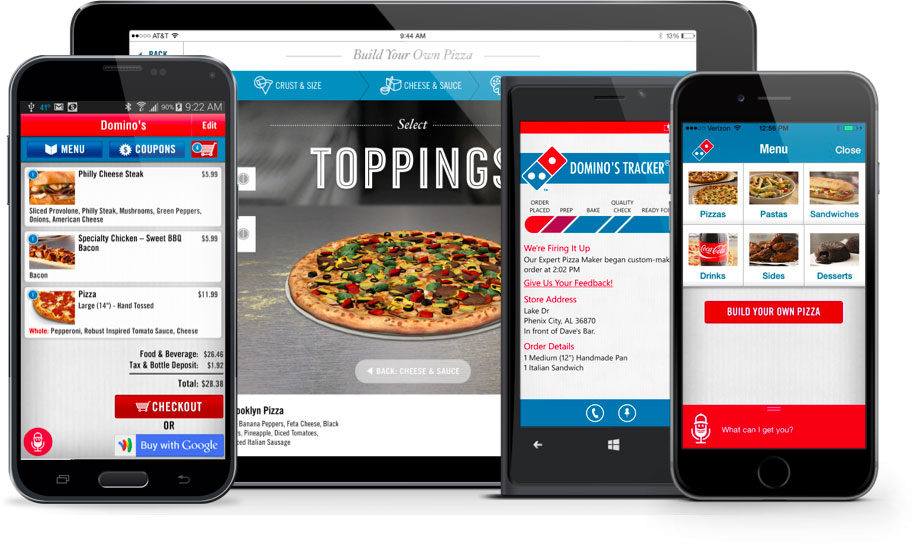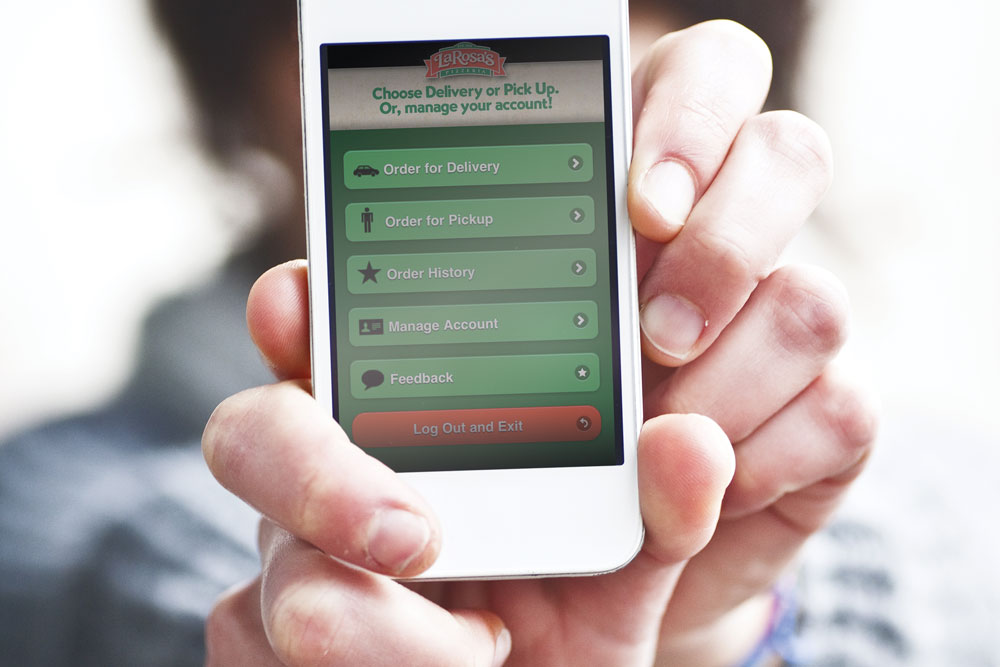For pizzeria operators, making the ordering process as simple and streamlined as possible has become increasingly important for success. In addition to offering online ordering for customers on the go, many have embraced another cutting-edge approach: mobile applications. When done correctly, a mobile app can integrate seamlessly into your existing e-commerce strategy and become a pivotal part of the ordering process for many customers.
For pizzerias looking to leverage the power of mobile apps, it’s important to understand the benefits of creating and deploying an app and to become familiar with best practices for vetting app developers. The goal is to create an app that will provide enhanced business value and help you sell more pizza.
 |
|
Making your app as user-friendly as possible for customers will help your bottom line in the end. Marco’s has a nice one-touch menu to automatically find the nearest store. |
Mass App-eal
If you don’t already know about the benefits of creating and deploying mobile apps, it’s time to get up to speed on this technology. With a mobile app, potential customers can place pizza orders with only a few quick touches on a phone screen. Robust apps can also store a customer’s favorite orders, payment information and even a delivery address; all of these features work in conjunction to save precious time, eliminate wasted efforts and improve the customer experience.
Apps can also generate more opportunities to upsell orders. By promoting new or featured products or sale items or by prompting customers to think about adding a side of breadsticks or a salad, you can boost the average total for an order. With this approach, customers see appealing sides and products they may not have thought about. Taking orders over the phone typically doesn’t present that opportunity—phone orders often feel rushed, order takers are harried, and many customers have come to dislike the experience of calling in to order food.
Apps offer the additional advantage of helping customers find special offers, even if they’ve lost the pizza coupons you sent them last week in the mail. Push notifications on apps can send information on new products, deals and limited-time offers directly to customers on their mobile devices—and today’s consumers tend to carry these devices with them at all times.
App-raising the Situation
Before diving in to app development, it’s important to have a clear understanding of what you’re looking for and how you want your app to work as a tool to help achieve your business goals. You will need to determine what success looks like for your app as a digital extension of your sales model. Think about the necessary features the app should include, such as ordering preference and payment information storage, and consider what you want the user experience to be like. For most operators, creating a mobile app will ultimately be about increasing sales and avoiding losing sales to competitors who do have an app in place.
Understand that a mobile app will make your brand an extension of people’s lives through their phones. A poorly designed app reflects badly on your company and can cast a shadow over both your brand and your products. Alternatively, a well-designed app with thoughtful, inviting user engagement reflects much better on your brand—and products—by providing customers with a positive experience.
Of course, budget considerations will be a major factor, especially for a smaller independent pizzeria owner. App creation costs depend largely on the scope of the work and features included in the app. These costs can range from thousands of dollars to millions, depending on the complexity of the app and the amount of coding time required. A good app, in other words, won’t be cheap to create, but consider the potential return on investment and how it can help increase your overall sales. The Domino’s (dominos.com) ordering app has been downloaded more than 11 million times, and digital orders account for more than 40% of the company’s U.S. revenue alone, cementing the app’s status as a critical part of the company’s ordering process. Creating an app can be a significant investment up front, but when the results lead to a major boost in sales over the long haul, the investment will quickly pay for itself.
Just keep in mind that cost typically depends on a myriad of factors. It’s much like building a house—the price ultimately depends on the size of the home, the materials used and more. When it comes to your app, remember: It’s better to do a few things really well than have a lot of features done poorly.
 |
|
The Domino’s ordering app has been downloaded more than 11 million times. |
App-roaching Development
Part of the cost equation also depends on the type of developer utilized to create your unique mobile app experience. More “generic” app development solutions may be conducive to tighter budget restraints, but the finished product will likely lack the individualized elements that make your brand unique. These types of solutions also tend to be less customizable, meaning that many of the key features critical for a successful pizza ordering app may need to be sacrificed at the expense of cost. If you can’t put your full weight and enthusiasm behind a mobile app experience, it’s only going to make it more difficult to convince customers to download and use the app.
When an app that cuts corners and doesn’t meet the needs of customers goes live in the app store, it ends up getting pulled. Designing an app twice is definitely costlier than doing it right the first time. You’ll want to hire an app developer who will pay attention to your needs and ask you questions up front about your goals and business objectives. Look for a company that, instead of trying to sell you something, will have a candid discussion from the very beginning about what you need, how to get you there and how to do it within budget.
Additionally, be sure to browse the app developer’s portfolio. What other apps have they done, or what brands have they worked for? An app development firm that has worked in the pizza industry before will already have a strong sense of the unique needs and challenges facing pizzeria owners. Leverage that expertise to your advantage. Make sure to download and review samples of apps they have created for other clients to get a sense of their design style and functionality.
Finally, understand that this is a time-intensive process. The full life cycle of the development of an app—from conception to the initial release of the project in the app store—can take three to four months. Even then, your initial release likely will not be perfect. Everything changes so fast with mobile technology that the best approach is to limit what you include in the first release so you can get feedback from users on what they would like to see more of. Then you can make adjustments and issue an updated version. Mobile users expect this—it not only helps create a dialogue, but it establishes an intimate relationship between users and the brand.
For brands in the pizza industry, mobile apps present significant opportunities for growth—both in terms of sales and customer satisfaction. Mobile apps are perfectly positioned for operators to leverage, and, in the near future, those with mobile apps will immediately have an advantage over those who don’t, thanks to the seamless online ordering process they will be able to provide to their customers.















